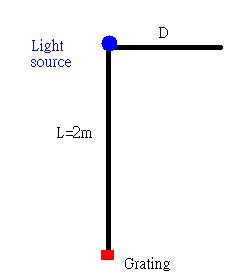LED stands for Light Emitting Diode. We also learned the basic concept of diode during the lecture.
In this experiment, we have four different color of LED's, which are red, green, yellow, and blue.
We use the same setup as we did in the gas spectra experience to determine the wave length of the light that is emitted from the diode.
Also, we measured the voltage drop across the diode to determine the power input of the LED.
We have a distance of 2m between the light source and the grating. The good thing about the grating we had is that it has a label on the side; thus, we also knew what is the grating size.
the equation we got to determine the wavelength is lambda=Dd/(sqrt(L^2+D^2)) where D is the distance of the spectra light and d is the grating size. L is the distance between the light source and the grating.
We use the same set up
But with the different numbers
d(m) | 1.67E-06 |
L(m) | 1.29 |
Ω | 680 |
LED | D(m) | Uncertain(cm) | Upper | Lower |
Red | 0.54 | 0.01 | 0.55 | 0.53 |
Green | 0.42 | 0.01 | 0.43 | 0.41 |
Blue | 0.38 | 0.01 | 0.39 | 0.37 |
Yellow | 0.49 | 0.01 | 0.5 | 0.48 |
LED | λ(m) | Uncertain(m) | Upper(m) | Lower(m) |
Red | 6.449E-07 | 1.016E-08 | 6.550E-07 | 6.346E-07 |
Green | 5.170E-07 | 1.113E-08 | 5.281E-07 | 5.058E-07 |
Blue | 4.719E-07 | 1.143E-08 | 4.833E-07 | 4.604E-07 |
Yellow | 5.930E-07 | 1.058E-08 | 6.035E-07 | 5.824E-07 |
LED | Voltage drop(v) | 1/λ(m-1) | Uncertain(v) | Upper | Lower |
Red | 1.86 | 1.551E+06 | 0.005 | 1.865 | 1.855 |
Green | 2.50 | 1.934E+06 | 0.005 | 2.505 | 2.495 |
Blue | 2.66 | 2.119E+06 | 0.005 | 2.665 | 2.655 |
Yellow | 1.90 | 1.686E+06 | 0.005 | 1.905 | 1.895 |
If we graph V vs. 1/Wavelength
we will get
The slope value we get is 1.573E-6 v*m. If we multiply q and divide speed of light we should get the value of Planck's constant which is 8.756E-34 J*s. The percent error of our result is about 33%. But we have a large range of uncertainties for all the variables and a significant amount from the small angle approximation. Thus, we can conclude that our experiment has succeed to measure Planck's Constant
The Red LED consumed the least amount energy and the Blue LED consumed the most. This reason is that Red has a longer wavelength (lower energy) but Blue has a shorter wavelength(higher energy) according to the equation
E=hc/λ where h is the planck's constant, c is speed of light, and λ is the wavelength.




No comments:
Post a Comment